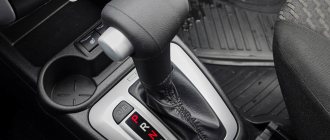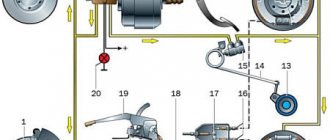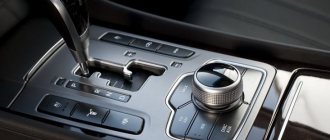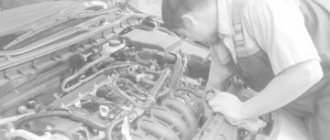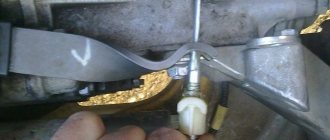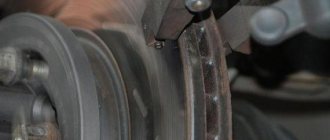Many drivers have had to deal in practice with such an incomprehensible and unpleasant situation when the automatic transmission of a car suddenly begins to act up, to function not as usual, but with obvious deviations from the norm. When it is switched, shocks appear; often, for no apparent reason, the automatic transmission “kicks” when braking or starting to move from a standstill.
Eliminating problems with automatic transmission when braking.
Why does the machine twitch?
An emergency situation, when the car’s automatic transmission “kicked” and twitched unpleasantly, is familiar to many. In such cases, some drivers, without delving into the reasons for what was happening, turned for help to service centers or to familiar professional automotive mechanics, who began to troubleshoot problems, often completely rebuilding the box, thoroughly changing one of the main blocks or even several of them . This method of adjusting an automatic transmission, of course, also has a right to life, however, it would be much more logical if the driver himself thoroughly understood the reasons for what happened in order to understand in the future what is happening.
Often it’s not that difficult to figure out. In modern cars with an automatic transmission, kicking is often caused by turning on the “Drive” mode. This problem can often be resolved by simply changing the oil in the transmission, after which the unwanted shocks will completely disappear. However, this does not always happen; sometimes even after a complete change of oil and filter element, no positive changes will occur, the shocks remain. Then the car owner will have to resort to full diagnostics in order to accurately find out the real cause and then eliminate it.
Shocks due to low oil level
The third reason that can make the machine “twitch” is the low oil level in the box.
The oil in an automatic transmission is the working fluid, thanks to which gear shifts occur, so its quantity in the box must be sufficient.
Sometimes it happens that the level can drop below o, and the owner does not have time to notice it. The reasons are simple - the oil in the machine may leak, or when replacing it, the technician may “forget” to set the required level.
One way or another, you need to monitor the oil level in the box and if it becomes lower than required, add oil to the automatic transmission.
Automatic transmission diagnostic methods
Many years of practice have made it possible to develop a clear and effective method for diagnosing a car’s automatic transmission in case of any malfunctions, even when the automatic transmission is pushed. This technique is identical for cars of any brand that has it, regardless of the manufacturer, and involves a set of verification actions. These include a thorough check:
- signs of deviation from the norm;
- quality and level of liquid;
- engine operation in low, medium, high speed modes;
- pressure in its hydraulic system.
I checked all the reasons - it didn’t help
If, after checking all the reasons described above, there is still no one that interferes with the normal operation of the automatic transmission, then it’s time to go to a good service center to diagnose the transmission, and the sooner the better.
In a good service, diagnostics are relatively inexpensive, and qualified technicians can easily express thoughts about the causes almost immediately, which can prevent further development of the breakdown and significantly increase the chances of inexpensive repairs. For example, very inexpensive diagnostics in the VilGud car service network >>>
What to do if the reason is ATF
Often the reason why a car experiences a shock or a jolt during braking is that the ATF level does not correspond to that recommended for normal operation of the unit. It turns out that if the working fluid has an excess or deficiency, this can provoke foaming. Then the automatic transmission pump fails to pump a sufficient volume of oil to the parts in contact one with the other. Constant oil deficiency leads to wear of some parts. Their forced contact “dry” ends in an unwanted jerk of the car, leading to strange jolts, and even sharp impacts when one of the gears is engaged. This is doubly undesirable for a car when it operates for a significant period of time in urban conditions, where there are constant changes in speed due to traffic jams, irregular traffic on roads with traffic lights, etc. In such conditions, problems with the automatic transmission progress literally before our eyes.
The following logical algorithm suggests itself: having detected the automatic transmission twitching when switching, the first step should be to check the fluid level. It should definitely be brought back to normal by adding the required amount or, if there is excess, draining the excess. Then check the fluid for cleanliness. If signs of contamination are found, replace it. It will also be necessary to change the filter, remove deposits from the filter mesh, etc. We must not forget that the box certainly requires that it be warmed up at a low temperature before starting to move.
Is it possible to “cure” automatic transmission kicks?
The vast majority of problems with automatic transmissions are somehow related to the quality or quantity of transmission fluid. Therefore, their elimination in most cases is associated with bringing the working fluid of the box to normal condition.
It often happens that the box operates on transmission fluid, with physical properties different from those laid down by the developers, for quite a long time. Long-term operation of an automatic transmission in such conditions leaves a mark on the “health” of the box - the box noticeably wears out, although this may not be noticeable to the driver.
For such automatic transmissions, a simple oil change may no longer be sufficient to eliminate shocks during operation. As an option to “treat” such an automatic transmission, you can try adding a special additive to the oil - an additive that will change the physical properties of the oil.
You can find a lot of all kinds of additives for automatic transmissions on sale, but few of them can actually positively affect the operation of the box.
For example, the tribotechnical composition “Suprotek” has proven itself very well, providing the components and assemblies of the car with noticeably more stable operation and an additional protective layer (not advertising, personal experience of those who have tried it). It is also worth noting that this additive, developed in Russia, is purchased en masse by the Ministry of Defense of the Russian Federation as a composition that increases the survivability of military equipment.
For example, you can buy Suprotek for automatic transmissions inexpensively and with delivery here >>>>
When the box has nothing to do with it
It should be noted that the reason why a car suddenly starts to twitch strangely when starting to move, braking or accelerating for no reason at all is not always the automatic transmission. There are cases when this occurs due to the influence of low-quality fuel or interruptions in the ignition system. Since the car is one system unit, a malfunction in the operation of the engine or ignition automatically leads to deviations in the functioning of the automatic transmission. Then car diagnostics are also inevitable.
The driver should make it an ironclad rule to follow technical recommendations and preventive measures that will make it impossible or, in the extreme case, delay as long as possible a malfunction in the operation of the vehicle. This is, first of all, filling the engine with only the high-quality oil recommended by the manufacturer. In addition, strict adherence to the interval for replacing filters and fluid and, as already noted, warming up the automatic transmission when using the car at low temperatures are mandatory. Of course, you also need to operate your car carefully and from time to time have it undergo a full technical inspection, using the services of reputable service centers and good diagnosticians.
Automatic transmission breakdown detection
On most modern cars, in the event of shocks or twitching of the automatic transmission, error codes are recorded in the memory of the on-board computer, which display certain malfunctions that occur with the car. As a rule, along with the appearance of errors, the “Check engine” warning light lights up on the dashboard.
However, there are cases when, when errors appear, the car’s on-board computer does not consider this error to be a serious enough breakdown, or this error appears and disappears, the computer does not turn on the “Check engine” warning light. That is, the car owner cannot understand whether there are any errors currently in the memory of the on-board computer and whether they could be the cause of automatic transmission jolts.
In this case, the car owner needs to read errors from the memory of the car’s on-board computer and decipher them. This can be done at almost any car service for money, or independently, using a special error scanner.
There are convenient universal car adapters that will help you read errors on any car using a regular smartphone. Such an adapter can significantly save time and money for the car owner (on car diagnostics). For example, the ELM-327 adapter is very convenient and popular, which can be ordered with home delivery.
The next step will be to decipher the error code and determine whether it affects the operation of the automatic transmission. Error codes for each car model can be found freely available on the Internet.
Oil cooler
The purpose of the radiator in an automatic transmission system is to cool the ATF fluid. When its performance characteristics decrease, the oil becomes very hot and burns. This not only spoils the fluid itself, but also affects the operation of the automatic transmission as a whole for the reasons described earlier.
The main reason why the radiator gradually fails is the replacement of transmission fluid under pressure . When performing this procedure on so-called high-pressure apparatuses, the system is installed in the gap between the cooling radiator and the automatic transmission itself. Next, the old oil is removed from the system under pressure and new oil is poured in its place. However, the process does not imply either replacing the oil filter or washing the transmission pan, including the radiator. Therefore, a situation arises when dirt from the bottom of the sump is forced to the top and clogs individual elements of the transmission, in particular, the radiator, oil filter, valve body, and solenoids.
The radiator consists of many small pipes and honeycombs, which simply become clogged with dirt. And as the temperature rises, it burns to its walls, which significantly reduces the efficiency of the oil cooler.
Accordingly, in order to get rid of shocks when changing gears in an automatic transmission, one of the options is to clean the ATF cooling radiator. From now on, it is advisable not to change the ATF fluid under pressure, but to change the filter along with it, and also clean the radiator (magnets). This will cost more, but in the long run it will extend the life of the automatic transmission as a whole.
Oil pump
In fairness, it is worth noting that the pump very rarely fails. Depending on the design, the pump can be installed in one of two places:
- directly behind the valve body;
- below on the pallet, unwinding with a chain from the drive shafts of the automatic transmission.
The design of the pump is very reliable, however, if there is mechanical damage or a manufacturing defect, it can also break. Accordingly, under such conditions, the transmission fluid will stop circulating at operating pressure or at all. The pressure will drop, which will lead to jerking when shifting gears, and in critical cases - complete failure of the gearbox.
Electronic control unit
In even rarer cases, the culprit that causes the automatic transmission to kick is the electronic engine control unit. In particular, its firmware may simply fail. However, in such “exotic” cases, not only jerks when changing gears, but also other malfunctions may appear. For example, the engine speed will be unstable, when the lever is mechanically switched to a certain mode, the box will not respond to this, and so on. In this case, it is necessary to perform computer diagnostics of the electronic unit. Moreover, in this case, it is advisable not to use the machine, but instead to bring a diagnostic device (preferably a laptop with the necessary program) directly to the machine. It is advisable not to reflash the control unit yourself. Firstly, this requires special hardware and software, and secondly, this is a responsible matter, and it is better to entrust this to specialists who provide a guarantee for their work.
Additional reasons
In some cases, it is not the gearbox that is to blame for automatic transmission kicks, but a poorly tuned engine. In particular, the throttle valve, spark plugs, injectors, air filter, engine oil. This is especially true for the throttle valve. It is advisable that it be clean to ensure normal air passage. Same with the air filter. In general, the integrated work of the elements listed above ensures a reduction in shocks during shifting and eliminates lengthy gear changes in automatic transmissions.
The causes of shocks when switching an automatic transmission may be the cushions on which the engine and transmission are mounted. The fact is that the motor and the box attached to it in the car’s design are mounted on special “pillows”, which are two metal plates with a rubber insert located between them. Over time (including under the influence of vibrations), rubber loses its properties, in particular, elasticity and does not work properly. This leads to shocks when changing gears. You can get rid of this by replacing the pillow/pillows with new ones.
On many older cars, the automatic transmission is controlled by a cable. The same goes for the accelerator pedal. Accordingly, you can try to adjust the switching of individual speeds at certain parameters - speed and torque. However, it is unlikely that you will be able to do this on your own; it is better to seek help from a car service center.
In old automatic transmissions used in foreign cars produced in 1990...2000 (mostly four-speed), brake bands were used instead of brake clutches. This is due to the simplicity and low cost of the design. However, the problem is that they failed quite quickly. And this was reflected, in particular, when switching not between all gears, but only between certain pairs of them. For example, between 1 and 2, 3 and 4. A classic example of such a box is an automatic transmission from Ford, model 4F27E. Repair in this case is impossible, and such a breakdown can only be “cured” by completely replacing the brake band.
Hydraulic unit
The second name for the hydraulic unit is hydraulic plate. This part of the automatic transmission is the control part, and consists of many small channels through which ATF fluid directly moves under pressure. Briefly, it can be noted that each gear has its own channel with liquid, which, under pressure, causes the clutches to compress or decompress.
Accordingly, if the mentioned small channels become clogged with dirty liquid, then the pressure will not be enough for normal operation of the clutches. They will not be able to compress and unclench normally, and jerks or jolts will appear in the behavior of the car.
The reasons for this are still the same - using dirty oil (delayed replacement), replacing ATF fluid under pressure. Cleaning the mentioned channels is possible only by dismantling and disassembling the gearbox, and this can be quite expensive.
Another reason associated with the valve body is plate wear . The fact is that the hydraulic unit consists of two plates, between which there is a special plate. The ball-shaped rod from the solenoid rests against it. This ensures that the pressure is closed (fixed). There is a hole in the specified plate, which is blocked by the specified ball. Over time, the hole breaks, which leads to minor jolts when changing gears on an automatic transmission. In order to get rid of this problem, it is necessary to grind the mentioned plate, or replace it with a new one in case of significant wear. In any case, it is necessary to dismantle the gearbox for detailed diagnostics and repairs.
The automatic transmission kicks. Why and what to do: 5 comments
The car is a Grand Cherokee 3.6, the automatic transmission is kicking, I found out the reason for myself, don’t repeat it, it’s dangerous. And so I tell you, the oil in the engine is 5-30 Acea with 3, 229.51, the reason is in it, namely, it is filled with Mobile 1 esp. The Chrysler MS 6395 standard for gasoline implies 5-20 and 5-30 ilsak with a viscosity at 100 g of -10.5, and a maximum of 11 of the latter (5-30). On the mobile it kicks, I filled it with amzoil signature 5-30, everything is perfect, even if the kicks are barely audible. Reason: nag 1 on Cherokee switches speed at 1800 rpm, and so on a mobile phone at these rpm the engine does not develop the required power and speed and when switching the gearbox pushes the car, (the oil is thick) with oil in the Amzoil 5-30 engine the engine spins up and revs easier the speed is am and it turns out that the engine pulls the box along with it, and it doesn’t push it. I checked everything was perfect 2 times with ms 6395 5-30 oil (amzoil and petrocanada). But there is one thing, these oils are low-viscosity and in traffic jams the pressure drops much lower than on Acea C3, you can ruin the engine, it’s better for the automatic transmission to undergo repairs than the engine, I checked the pressure on the on-board computer. Mobile oil has the best protection against wear, but slightly takes away engine power, so the engine becomes dull and because of this there are jolts, kicks, lack of speed at the same speed on these oils, on one it kicks, on the other it’s perfect, for me it’s like that , someone will say nonsense, nonsense, if you have a Cherokee wk2 gasoline, check it for yourself, if there are no Moscow traffic jams, the difference in consumption is Benz Mobile 12.7 average, Amzoil 11.4 average.
Take chlorpromazine. This is the only way to save you......
I’m talking about the automatic transmission. There are a million recommendations, one of them. Replace the bolt on the automatic transmission and it will stop kicking. Specifically how. Is it possible for everything?
In what cases does the box kick?
There are many reasons why the normal operation of an automatic transmission is disrupted. Let's consider the main ones, as well as possible solutions to problems:
- The automatic transmission kicks while driving. This indicates a malfunction of the valve body or torque converter. They will probably need to be replaced.
- Shocks are felt in the automatic transmission during braking. A sign of a faulty clutch or valve body. Replacement of failed spare parts will be required.
- The box jerks when engaging reverse gear. A broken sensor or possible problems with the torque converter. Replacement required.
- The automatic transmission kicks when cold. Transmission components are worn out. Replacement of worn parts.
Let's look at some cases in more detail.
